Attributes
- Sizes 3″ through 18″ diameter – larger sizes available
- Laminated 3 ply bellows
- Austenitic stainless steel and high nickel alloy bellows
- Maximum flexibility and extended life

Attributes
Series 2509-2511 Laminated Bellows Expansion Joints are designed specifically for maximum flexibility in low pressure applications such as engine exhaust systems, fan connectors, ventilation ducting and air handling systems. The laminated bellows construction permits axial, lateral and angular movements without exerting high spring forces on the system, and the internal damping provided by the laminations limits resonate vibration.
Series 2509-2511 Laminated Bellows Expansion Joints are ideal for direct installation on engine exhaust manifolds, turbochargers and fan inlet and exhaust connections. Hyspan Series 2504-2507 1 Ply Expansion Joints are similar designs with single ply bellows that less suitable for vibration applications but ideal for use throughout the ducting and piping. Catalog sizes range from 6″ through 48″ diameter.
All Series 2509-2511 Laminated Bellows Expansion Joints are designed for a maximum pressure (including test pressure) of 15 psig and a full vacuum. They are intended for applications such as engine exhaust, fan connections, vents and other very low pressure applications. The design temperature varies with the construction. The materials of construction for standard assemblies are: type 304 stainless steel bellows, van stone ends and flow liners; ASTM A-36 carbon steel plate flanges and angle flanges, and ASTM A-53 standard weight carbon steel pipe weld ends.
Optional materials are available including the substitution of stainless steel for flanges and pipe. Recommended design temperatures are 775ºF for Types 2509 & 2511 with carbon steel fittings, 1100ºF for Type 2510 with carbon steel backup flanges and 1250ºF for all configurations if the component parts are stainless steel. Consult Hyspan for turbocharger and other high pressure applications.
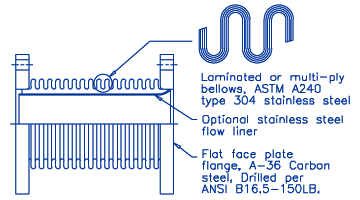
Axial Travel
Axial motion applications with anchors on pipe/duct centerline as shown in the axial travel illustration. The maximum Axial Compression and Axial Extension for each configuration is given in Columns 3 & 4 of the Design Data. Most Series 2500 applications do not require the amount of rated axial extension. For these applications the expansion joint can be ordered preset if additional travel is needed. As an example a 3″ joint (-040-5) rated for 5″ compression factory cold sprung 1″ (extended 1″) can be rated for 5″ compression. The allowable axial extension will be reduced from 2.5″ to 1.5″.
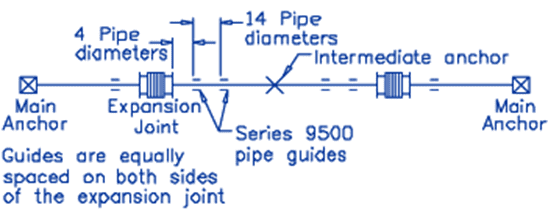
Lateral Offset
The lateral offset installation illustrated is a typical application of a Series 2500 Laminated Bellows Expansion Joint installed on an engine exhaust, fan intake or discharge. The high flexibility and internal damping provided by the laminated construction permits absorption of lateral movement from thermal expansion or mechanical motion. Refer to Column 5 of the Design Data for the maximum lateral off-set of each configuration and Flow Liner section regarding clearances. For applications of this type, it is good practice to add Tie Rods to the expansion joint – see Tie Rods below.
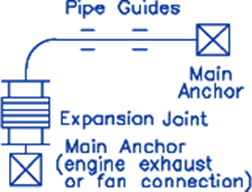
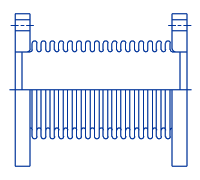
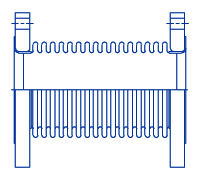
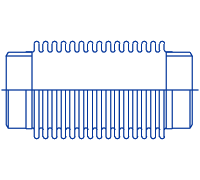
Flow liners or internal sleeves are optional features that are available for all configurations. Liners provide a means of isolating the bellows element from direct contact with the flow and as a result eliminating flow induced vibration, minimizing pressure loss, and creating dead air space between the bellows that insulates the bellows. Flow velocity and operating temperature are important for calculating the correct liner thickness and construction. Standard EJMA liners are rated to 100 FPS at 200 F. Most exhaust and air applications exceed these values requiring specially calculated liners. Thermal expansion applications typically include large axial motions with limited to no lateral when anchors are mounted to the pipe or duct centerline. To maximize flow and minimize pressure drop when liners are ordered, the standard liner ID is set to allow ¼” lateral, or the lesser lateral rating, when used with schedule Standard pipe. For greater lateral offset, or additional liner assistance, consult Hyspan.
Hyspan installed flow liners follow the recommendations outlined in the Standards of the Expansion Joint Manufacturers Association (EJMA) summarized as follows:
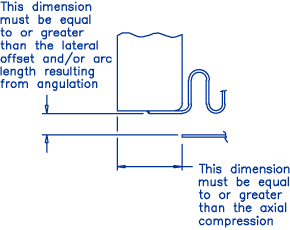
Tie Rods
Tie rods are available as an option on Series 2504-2507 1 Ply Bellows Expansion Joints. They react the pressure thrust in piping and ducting that is not anchored such as the lateral offset application illustrated above. They may also function as Limit Rods. Limit rods do not react the pressure thrust in service but they are designed to react the pressure thrust in the event of an anchor failure. Their main function is to limit the axial extension and compression of the bellows to the rated values. Hyspan normally refers to both tie rods and limit rods as Tie Rods but the factory settings are important – factory settings as Tie Rods do not permit axial extension but limits compression to the rated value of the bellows. Factory settings as Limit Rods will permit axial extension and compression in accordance with the rated travel specified in the Design Data.
All Stainless Steel Construction
Some applications require all stainless steel construction. These may include high-temperature air, specialty exhaust, wastewater treatment plant digester gas and process air piping, and cryogenic liquid Helium escapement piping for MRI machines. Note: for cold temperature applications the expansion joint undergoes extension and must be preset for reversed motions. Consult Hyspan for assistance.
Series 2529-2531 is manufactured from all 304/304Lstainless steel materials. Flanges are ½” (12mm) thick plate with ANSI/ASME 150# drilling. 2524 Weld ends are schedule 10S wall.
Series 2539-2541 is manufactured from all 316/316L stainless steel materials. Flanges are ½” (12mm) thick plate with ANSI/ASME 150# drilling. Weld ends are schedule 10S wall.
More Plies for High Pressure and Extreme Vibration
Higher pressures or extreme vibration often benefit from more plies than the 3-ply standard designs. Increased mass aids in dampening vibration. Many plies at different diameters, even if by a small amount, can provide frequency variance within the bellow. For higher pressures, vibration, or frequent failure applications consult Hyspan for design assistance.
Nickel Alloys
High nickel alloys such as Inconel 625 and 617 are available for pressure, temperature, and corrosion resistance. In high-pressure applications, high-strength nickel alloys may also provide lower spring rates
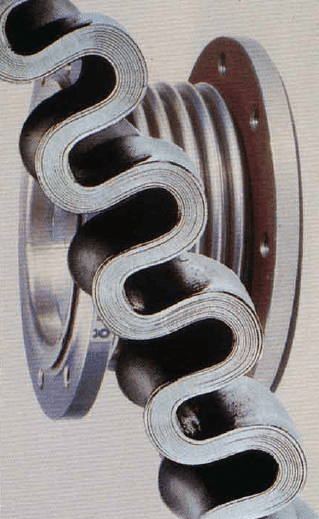
Refer to the illustrations above for the configuration required. Refer to the Design Data table for the available motions, spring rates, lengths and weights.
Example:
24″ nominal diameter
Single fixed flange,
Standard bellows material, 304 stainless steel
Standard flange material A-36 carbon steel
3.0″ axial compression, 1.5″ axial extension
(2505L-086-3.0 with Flow Liner)
